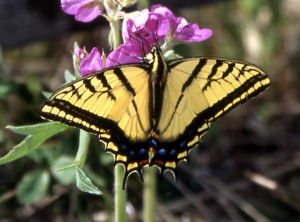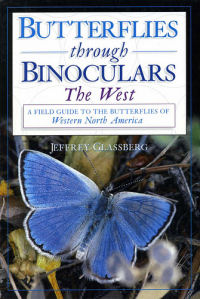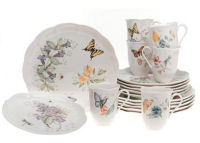
HOME
INTRO
SYMBOLS
ALMANAC
ECONOMY
GEOGRAPHY
STATE MAPS
PEOPLE
FORUM
NEWS
COOL SCHOOLS
STATE QUIZ
STATE LINKS
BOOK STORE
MARKETPLACE
NETSTATE.STORE
NETSTATE.MALL
GUESTBOOK
CONTACT US

Arizona State Butterfly: Two-tailed Swallowtail
National Park Service Photograph by Jim Peaco
Arizona Law
The following information was excerpted from the Arizona Revised Statutes, Title 2, Chapter 10.
Title 41 State Government
Chapter 4.1 HISTORY, ARCHAEOLOGY AND STATE EMBLEMS
Article 5 State Emblems
41-860. State butterfly
A. The papilionidae papilio multicaudata, two-tailed swallowtail is the official state butterfly.
B. Designation of the state butterfly pursuant to this section shall not constitute grounds for protection of the butterfly or its habitat.
Sources...
Arizona Revised Statutes. Arizona State Legislature. 2009. 14 February 2009 <http://www.azleg.gov/ArizonaRevisedStatutes.asp>
Shearer, Benjamin F. and Barbara S. State Names, Seals, Flags and Symbols: A Historical Guide Third Edition, Revised and Expanded. Westport, Conn: Greenwood Press, 3 Sub edition, 2001.
Additional Information

Arizona Butterflies & Moths
by James Kavanagh
Fact Sheet: Arizona Fish and Game Department.
Two-tailed Swallowtail: Butterflies and Moths of North America - Occurrence maps, species accounts, checklists, and photographs.
Papilio m. multicaudata W. F. Kirby, 1884: Butterflies of America - Interactive Listing of American Butterflies (from Alaska to Panama and the Caribbean).
Arizona Butterflies and Moths: The Firefly Forest - Discovering and enjoying nature.
State Butterflies: Complete list of official state butterfliess.
More symbols & emblems: Complete list of official Arizona state symbols.
Arizona Butterflies & Moths: An introduction to 72 familiar species, by James Kavanagh. 12 pages, Waterford Press; 1st edition (May 1, 2008) A pocket reference guide to the butterflies and moths indigenous to Arizona. This durable guide is printed on laminate material and folds for convenient carrying. It is an essential identification guide in the field or in the backyard.
Where Butterflies Grow , by Joanne Ryder, 32 pages. Puffin (June 1, 1996) Reading level: Ages 4-8. In a field of lacy leaves, a small caterpillar hatches, grows, and sheds its skin, becoming a smooth, green creeper. It eats and changes some more, then in a sequence of remarkable close-ups, spins a sliken sling in which to pupate--until it finally bursts forth as a brilliant black swallowtail butterfly. Includes suggestions on how children can grow butterfiles in their own gardens.
I Wish I Were a Butterfly, by James Howe. 40 pages. Voyager Books (February 28, 1994) Reading level: Ages 4-8. After the frog at the pond's edge tells him that he's ugly, the cricket of Swampswallow Pond loses his zest for life and for singing. The glowworm and the ladybug try to persuade the cricket that he's just as good as the rest of them, while the dragonfly declares, "Wishing is a waste of time." Finally, the Old One, a spider who lives on the other side of the pond, spins a wise tale about the real beauty of friendship and convinces the cricket to sing again. A simple fable that deserves to stay in print a long, long, time.
Peterson First Guide to Butterflies and Moths, by Paul A. Opler, edited by Roger Tory Peterson. 128 pages, Houghton Mifflin Harcourt; 2nd edition (February 20, 1998) Peterson First Guides are the first books the beginning naturalist needs. Condensed versions of the famous Peterson Field Guides, the First Guides focus on the animals, plants, and other natural things you are most likely to see. They make it fun to get into the field and easy to progress to the full-fledged Peterson Guides. DESCRIPTION
The Butterfly Book: A Kid's Guide to Attracting, Raising, and Keeping Butterflies, by Kersten Hamilton. 40 pages. Avalon Travel Publishing; 1st edition (March 26, 1997. Reading level: Ages 9-12. An introduction to the life cycle, food, habitat, and behavior of butterflies shares advice on butterfly observation and conservation, explaining how to design a garden to attract butterflies and offering a color identification guide to twenty common North American butterflies.

Butterflies Through Binoculars-The West
by Jeffrey Glassberg
Butterflies through Binoculars: The West, by Jeffrey Glassberg. 384 pages, Oxford University Press, USA (July 26, 2001) Featuring an extensive array of photographs, this field guide offers a comprehensive display of all the magnificent butterflies of the western region, stretching from the plains of middle America to the Pacific coast, and from southwestern Canada all the way to the Hawaiian islands. From butterfly biology to butterfly conservation, this useful and practical field guide provides all the necessary information to make your butterfly experience a success.
National Audubon Society Field Guide to North American Butterflies, 928 pages. Knopf; Chanticleer Press ed edition (July 12, 1981) A handy field guide with more than 1,000 photographs of all the butterflies of North America north of Mexico, including all true butterflies, the most common skippers, and many migrants and strays. The color plates are visually arranged by shape and color, and thumb-tab silhouettes provide a convenient index to identification of butterflies in the field. The species account for each butterfly provides measurements, descriptions of each stage of the life cycle, and information on coloring or distinguishing markings, flight period, habitat, and range.
A Field Guide to Western Butterflies, by Paul A. Opler. 512 pages. Houghton Mifflin Harcourt; Rev Sub edition (May 15, 1998) Includes more than 590 species, illustrated in lifelike positions on beautiful new color plates. With descriptions of all the butterflies that occur west of the 100th meridian in the United States and Canada, this guide has accurate information on ranges, habitats, flight seasons, food plants, and more. Brand-new color range maps and more than 100 color photographs accompany the species descriptions.
The Life Cycles of Butterflies: From Egg to Maturity, by Judy Burris and Wayne Richards. 160 pages. Storey Publishing, LLC (April 1, 2006) This book describes in text and photos the butterflies that commonly visit gardens in the eastern states. Beginning with a chapter that looks at the basics of butterfly egg laying, the growth of caterpillars, metamorphosis, and butterfly behavior, the authors move to the heart of the book. With exquisite close-up photography, the eggs, caterpillars, chrysalids, and adults of 23 well-known butterflies are revealed.
Attracting Butterflies & Hummingbirds to Your Backyard, by Sally Roth. 304 pages. Rodale Books (October 24, 2002) If you have never read one of Ms. Roth's books you are in for a real treat. Her writing style is wittily informative which makes us enjoy our lessons. She not only teaches us which plants to use in our gardens to attract both these winged wonders, but how to create the kinds of gardens they prefer. Shelter, water, host plants for butterfly caterpillars, and even fruit feeders and hibernating boxes are among the topics within these pages.
Stokes Butterfly Book: The Complete Guide to Butterfly Gardening, Identification, and Behavior, by Donald & Lillian Stokes, Ernest Williams. 96 pages, Little, Brown and Company; 1st edition (October 17, 1991) This popular guide to attracting, identifying, and enjoying all the common North American species of butterflies includes 149 full-color photos, 65 range maps, and two sample garden plans.

Lenox Butterfly Meadow
Lenox Butterfly Meadow Tableware Collection, Summer teas and spring brunches call for dinnerware as fresh and lovely as the weather. The Lenox Butterfly Meadow pattern features a garden motif of butterflies, bumblebees, ladybugs, and blossoms set against an ivory background. The delicately rendered images, created by Lenox artist Louise Le Luyer, vary between pieces for a charmingly playful table. Crafted from fine bone porcelain, the pattern has gently scalloped rims and is safe in the oven, microwave, and dishwasher. Like all Lenox dinnerware, the Butterfly Meadow line is covered by a lifetime replacement policy.
 Custom Search
Custom Search



